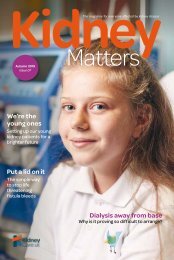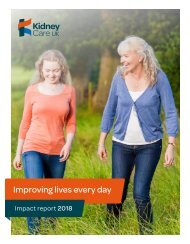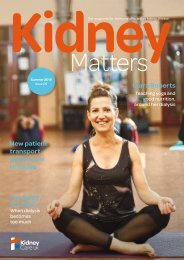Kidney Matters - Issue 16 Spring 2022
Kidney Matters is our free quarterly magazine for everyone affected by kidney disease. This issue includes features on delayed graft function, the impact of CKD on families, friends and care-partners, improving organ donation, a husband's perspective on the challenges faced from caring for someone with CKD, and an article all about a family's journey from dialysis to transplant and all the things in between. As well as this, the Kidney Kitchen features a warming pear and blackberry crumble, perfect for Valentine's Day! We know that being a kidney patient can be tough at times and that accessing the right help at the right time isn’t always easy. We’ve spent a great deal of time talking and listening to kidney patients about what we can do to address this at every stage of kidney disease. The response was overwhelmingly ‘improved communication’ on what is going on in the kidney world, how other patients manage their life with kidney disease and what is available to them in terms of support and how to access it. Kidney Matters has been developed to tackle this as well as the many other issues kidney patients face in day-to-day life. Along with shared patient experiences, Kidney Matters provides information on how to access emotional and practical support, financial assistance through our grant schemes, advice from leading kidney specialists and tips on how to keep as well as possible by eating a healthy diet whilst on dialysis.
Kidney Matters is our free quarterly magazine for everyone affected by kidney disease.
This issue includes features on delayed graft function, the impact of CKD on families, friends and care-partners, improving organ donation, a husband's perspective on the challenges faced from caring for someone with CKD, and an article all about a family's journey from dialysis to transplant and all the things in between.
As well as this, the Kidney Kitchen features a warming pear and blackberry crumble, perfect for Valentine's Day!
We know that being a kidney patient can be tough at times and that accessing the right help at the right time isn’t always easy. We’ve spent a great deal of time talking and listening to kidney patients about what we can do to address this at every stage of kidney disease. The response was overwhelmingly ‘improved communication’ on what is going on in the kidney world, how other patients manage their life with kidney disease and what is available to them in terms of support and how to access it.
Kidney Matters has been developed to tackle this as well as the many other issues kidney patients face in day-to-day life. Along with shared patient experiences, Kidney Matters provides information on how to access emotional and practical support, financial assistance through our grant schemes, advice from leading kidney specialists and tips on how to keep as well as possible by eating a healthy diet whilst on dialysis.
You also want an ePaper? Increase the reach of your titles
YUMPU automatically turns print PDFs into web optimized ePapers that Google loves.
33
Introducing the Kidney Failure Risk
Equation
NICE’s new guidelines recommend that doctors
should use the Kidney Failure Risk Equation (KFRE) to
calculate the likelihood that someone with CKD stages
3a to 5 will need dialysis or a transplant within the next
five years. The KFRE combines an individual’s urine
albumin-creatinine ratio (ACR), eGFR, sex and age to
calculate this risk. The equation has been validated
in more than 30 countries including the UK, and is
currently the most accurate and efficient way of
finding out an individual’s risk of kidney failure.
Rupert says: “The KFRE means that we can give
patients a clearer idea of their risk: for example, a 25%
or one in four risk of needing dialysis or a transplant
within five years is much clearer to a patient than
being told that their kidney function is at 25%. More
work is needed, but we hope that the KFRE will help
to indicate the right time for a patient to be referred
for their vascular access, so avoiding starting dialysis
with a line. At the same time, KFRE may help to reduce
unnecessary fistula operations for people who remain
at the same eGFR for years.
“The equation also highlights the importance of ACR,
which probably has more influence on risk than eGFR.
I hope that the KFRE will encourage and promote
measurement of ACR, especially in primary care where
we know that about two out of every three people
with CKD and without diabetes do not get their ACR
measured each year as recommended.”
A new treatment to prevent kidney failure
NICE’s CKD guideline recommended using a new class
of drug, the SGLT2 inhibitors, to slow progression
of kidney disease in people with CKD and type 2
diabetes. More recently, in separate guidance, NICE
has recommended that a specific SGLT2 inhibitor,
dapagliflozin, can also be given to people with CKD but
without diabetes (see Table).
The SGLT2 inhibitors work by blocking
the sodium glucose cotransporter-2
(SGLT2)
protein in the kidneys.
This prevents the kidneys
from reabsorbing glucose
back into the blood so
that it is excreted in the
urine. At the same time,
the SGLT2 inhibitors
prevent kidney damage
by reducing pressure
and inflammation. They
also help to stop protein
from leaking into the
urine, and reduce blood
pressure and body
weight.
“As kidney doctors, we will have to warn patients and
GPs that there is a small drop in eGFR after starting
an SGLT2 inhibitor, which then stabilises, but we know
that these drugs are safe and effective based on the
clinical trials,” says Rupert.
Dapagliflozin, like the other SGLT2 inhibitors, was
originally studied and approved for the treatment of
diabetes. Large clinical trials subsequently showed
that, in both diabetic and non-diabetic CKD, adding
dapagliflozin to current standard care with an
angiotensin-converting enzyme (ACE) inhibitor (-pril
drug) or an angiotensin receptor blocker (ARB; -sartan)
is significantly more effective than standard care
alone, reducing the risk of worsening kidney function,
kidney failure, or death from causes related to the
kidneys or the cardiovascular system.
Rupert concludes: “The introduction of ACE inhibitors
20 years ago transformed the management of diabetic
and non-diabetic CKD. I think that SGLT2 inhibitors
will in time be used as widely as ACE inhibitors and will
revolutionise kidney care in the same way.”
The Kidney Failure Risk Equation is funded by an educational
grant from AstraZeneca, the manufacturers
of dapagliflozin.
To find out more about NICE’s CKD
recommendations, go to
www.kidneycare.org/learn-more
LEARN MORE

















